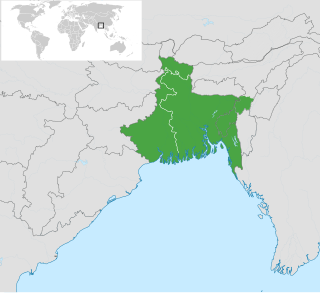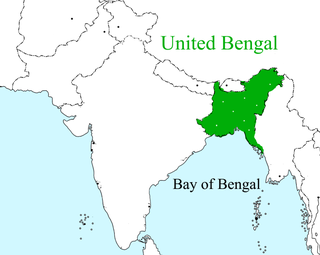Related Research Articles

Bengal is a historical geographical, ethnolinguistic and cultural term referring to a region in the eastern part of the Indian subcontinent at the apex of the Bay of Bengal. The region of Bengal proper is divided between modern-day Bangladesh and the Indian state of West Bengal. The Indian states of Assam, Jharkhand, Bihar, Chhattishgarh and Tripura as well as the union territory of Andaman and Nicobar islands have a sizeable Bengali population. A large Bengali diaspora exists across the world. Bengali is the sixth-most spoken language in the world.

The Partition of India in 1947 was the change of political borders and the division of other assets that accompanied the dissolution of the British Raj in the Indian subcontinent and the creation of two independent dominions in South Asia: India and Pakistan. The Dominion of India is today the Republic of India, and the Dominion of Pakistan—which at the time comprised two regions lying on either side of India—is now the Islamic Republic of Pakistan and the People's Republic of Bangladesh. The partition was outlined in the Indian Independence Act 1947. The change of political borders notably included the division of two provinces of British India, Bengal and Punjab. The majority Muslim districts in these provinces were awarded to Pakistan and the majority non-Muslim to India. The other assets that were divided included the British Indian Army, the Royal Indian Navy, the Royal Indian Air Force, the Indian Civil Service, the railways, and the central treasury. Provisions for self-governing independent Pakistan and India legally came into existence at midnight on 14 and 15 August 1947 respectively.
Events in the year 1947 in India. It was a very eventful year as it became independent from the British crown, resulting in the split of India and Pakistan. Many people died during partition and India became a democracy.

Hinduism is the second largest religious affiliation in People's Republic of Bangladesh, as according to the 2022 Census of Bangladesh, approximately 13.1 million people responded that they were Hindus, constituting 7.95% out of the total population of 165.15 million people. In terms of population, Bangladesh is the third-largest Hindu populated country of the world, just after the neighboring republics of India and Nepal in the subcontinent. Hinduism is the second-largest religion in 61 out of 64 districts of Bangladesh, but there is no Hindu majority district in Bangladesh.

The Partition of Bengal in 1947, part of the Partition of India, divided the British Indian Bengal Province along the Radcliffe Line between the Dominion of India and the Dominion of Pakistan. The Bengali Hindu-majority West Bengal became a state of India, and the Bengali Muslim-majority East Bengal became a province of Pakistan.

Since its independence in 1947, India has accepted various groups of refugees from neighbouring countries, including partition refugees from former British Indian territories that now constitute Pakistan and Bangladesh, Tibetan refugees that arrived in 1959, Chakma refugees from present day Bangladesh in early 1960s, other Bangladeshi refugees in 1965 and 1971, Sri Lankan Tamil refugees from the 1980s and most recently Rohingya refugees from Myanmar. In 1992, India was seen to be hosting 400,000 refugees from eight countries. According to records with the Union Ministry of Home Affairs, as on January 1,2021, there were 58,843 Sri Lankan refugees staying in 108 refugee camps in Tamil Nadu and 54 in Odisha and 72,312 Tibetan refugees have been living in India.

The Noakhali riots were a series of semi-organized massacres, rapes and abductions, combined with looting and arson of Hindu properties, perpetrated by the Muslim community in the districts of Noakhali in the Chittagong Division of Bengal in October–November 1946, a year before India's independence from British rule.
This is a list of States and Union Territories of India by Bengali speakers at the time of the 2011 Census.

Bengali Hindus are an ethnoreligious population who make up the majority in the Indian states of West Bengal, Tripura, Andaman and Nicobar Islands, Jharkhand, and Assam's Barak Valley region. In Bangladesh, they form the largest minority. They are adherents of Hinduism and are native to the Bengal region in the eastern part of the Indian subcontinent. Comprising about one-third of the global Bengali population, they are the second-largest ethnic group among Hindus after Hindustani Hindus. Bengali Hindus speak Bengali, which belongs to the Indo-Aryan language family and adhere to Shaktism or Vaishnavism of their native religion Hinduism with some regional deities. There are significant numbers of Bengali-speaking Hindus in different Indian states. According to the census in 1881, 12.81 per cent of Bengali Hindus belonged to the three upper castes while the rest belonged to the Shudra and Dalit castes.

Greater Bangladesh, or Greater Bengal is the irredentist ideology of Bangladesh to inevitably expand its territory to include the Indian states that currently has, or historically had, large populations of ethnic Bengali people. These include West Bengal, Bihar, Odisha, and Jharkhand to the west, Sikkim to the north, and the states of Arunachal Pradesh, Assam, Meghalaya, Tripura, Mizoram, Manipur, and Nagaland to the east. Greater Bangladesh would naturally therefore take on the more inclusive title of Greater Bengal, as her people would be united under a common ethnicity and heritage based on language rather than one based on religion.

The 1964 East Pakistan riots refer to the massacre and ethnic cleansing of Bengali Hindus from East Pakistan in the wake of an alleged theft of what was believed to be the Prophet's hair from the Hazratbal shrine in Jammu and Kashmir in India. The salient feature of the pogroms was its urban nature and selective targeting of Bengali Hindu owned industries and merchant establishments in the capital city of Dhaka. This resulted in unending waves of Bengali Hindu refugees in neighbouring West Bengal. The refugee rehabilitation became a national problem in India, and hundreds of refugees were resettled in Dandakaranya region of Odisha & Madhya Pradesh.

The 1950 East Pakistan riots took place between Hindus and Muslims in East Pakistan, which resulted in hundreds of thousands of Hindus being killed in pogroms.
The Bengali Hindu diaspora is the worldwide population of the Bengali Hindus of Indian and Bangladeshi origin.
Bongal Kheda was a xenophobic movement in Assam, India, orchestrated by native Assamese job seekers which aimed to purge out non-native job competitors — primarily, middle-class Hindu Bengalis. Soon after the Independence of India, the Assamese Hindu middle class gained political control in Assam and tried to gain social and economic parity with their competitors, the Bengali Hindu middle class. A significant period of property damage, ethnic policing and even instances of street violence occurred in the region. The exact timeline is disputed, though many authors agree the 1960's saw a height of disruption. It was part of a broader discontent within Assam that would foreshadow the Assamese Language Movement and the anti-Bangladeshi Assam Movement.
The Dandakaranya Project, or the DNK Project, was the form of action the Indian government designed in September 1958 for the settlement of displaced persons from Bangladesh and for integrated development of the area with particular regard to the promotion of the interests of the local tribal population. The particular focus was on Bengali refugees from East Pakistan moving to lands and resources in Odisha and Chhattisgarh. To implement this project, the Government of India established the Dandakaranya Development Authority.
An illegal immigrant in India is a foreigner who has entered India either without valid documents or who initially had a valid document, but has overstayed beyond the permitted time, as per the general provisions of the Citizenship Act as amended in 2003. Such persons are not eligible for citizenship by registration or naturalisation. They are also liable to be imprisoned for 2–8 years and fined.

Bengal was a historical region in the Eastern South Asia, which is politically split today between the South Asian republics of Bangladesh and India. Due to its long history and complicated political divisions, various names have been used to refer to the region and its subsections. The name Bangla is used by both Bangladesh and West Bengal in international contexts. In the Bengali language, the two Bengals each use a different term to refer to the nominally identified nation: Bānglā and Baṅga
The Bengali Language Movement is a campaign to preserve Bengali language and Bengalis culture and to oppose anti-Bengali sentiment in India. The movement was started in Manbhum in 1940, ahead of the Partition of India which allocated eastern Bengal to the new nation of Pakistan and led to the relocation of many Bengali communities. In 1947 British India bifurcated into India and Pakistan. The population of the eastern part of Bengal was majority Muslim, and was incorporated into Pakistan. Bengali Hindus in this eastern region migrated to India, principally settling in West Bengal, Chhattisgarh, Dandakaranya and Odisha, Maharashtra, Karnataka. The Movement remains prominent in Assam, Jharkhand, Bihar, Chhattisgarh and Karnataka.

Bengali Hindus are the second-largest Hindu community just after Assamese Hindus in Assam. As per as estimation research, around 6–7.5 million Bengali Hindus live in Assam as of 2011, majority of whom live in Barak Valley and a significant population also resides in Assam's mainland Brahmaputra/Assam valley. Most Bengalis in Assamese-dominated Brahmaputra valley are immigrants from neighbouring East Bengal and Tripura, while Bengalis in Barak Valley region of Assam are mostly native. Assam host the second-largest Bengali Hindu population in India after West Bengal.
Discrimination against Bengalis in India comprises negative attitudes and views on Bengalis in India. Though Bengalis have lived in different parts of India for centuries, they are subject to widespread discrimination. This can be either by any other community or in any particular place, due to reasons like inhabitation, discriminating sentiments, political reasons, Government actions, anti-Bangladeshi sentiment etc. The discriminative condition of Bengalis can be traced from Khoirabari massacre, Nellie massacre, Silapathar massacre, North Kamrup massacre, Goreswar massacre, Bongal Kheda etc. This has led to emergence of Bengali sub-nationalism in India as a form of protest and formation of many pro-Bengali organisations in India.
References
- ↑ US State Department, "Foreign Relations of the United States, 1969–1976", Volume XI, South Asia Crisis, 1971", Page 165
- ↑ "Dandakaranya Project". education.nic.in. Archived from the original on 5 February 2012. Retrieved 4 July 2016.
- ↑ Heitzman, James; Worden, Robert L. (September 1988). Bangladesh: A Country Study (PDF). Library of Congress. p. 57.
- ↑ Elahi, K M (2003). "Population, Spatial Distribution". In Islam, Sirajul; Jamal, Ahmed A. (eds.). Banglapedia: National Encyclopedia of Bangladesh (First ed.). Asiatic Society of Bangladesh. Archived from the original on 5 October 2008.
- ↑ "Refugee Relief and Rehabilitation". Government. Egiye Bangla. Retrieved 20 April 2018.
- ↑ Dasgupta, Abhijit. "The Puzzling Numbers: The Politics of Counting Refugees in West Bengal" (PDF). Table 1.2, Page 66. South Asian Refgees Watch, Vol. 2, No. 2, December 2000. Retrieved 20 April 2018.
- 1 2 Chakravartty, Gargi. "Coming Out of Partition: Refugee Women of Bengal". www.weeklyholiday.net. Archived from the original on 6 January 2007. Retrieved 4 July 2016.
- 1 2 "The East Bengal Refugees". www.catchcal.com. Archived from the original on 25 September 2009. Retrieved 4 July 2016.
- 1 2 "The Hindu : A home ... far from home?". www.hinduonnet.com. Archived from the original on 5 March 2007. Retrieved 4 July 2016.
{{cite web}}: CS1 maint: unfit URL (link)